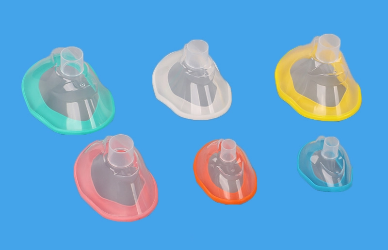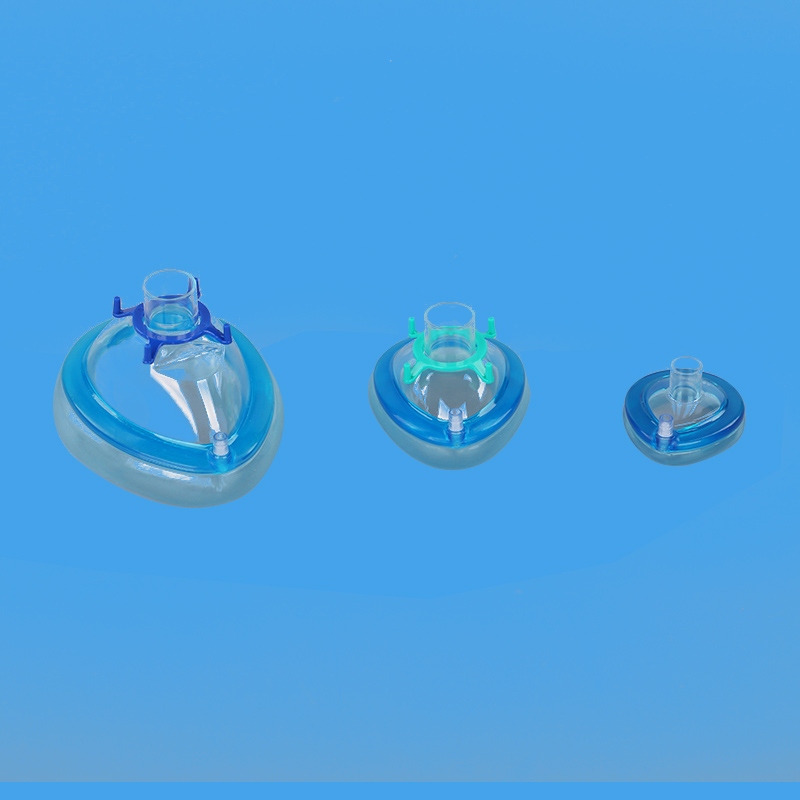-



Choosing The Right Anesthesia Mask: Fit, Material, And Patient Comfort
Views: 335 Author: Site Editor Publish Time: 2025-06-19 Origin: Site

In the perioperative environment, anesthesia masks serve as the critical interface between patient and anesthetic delivery system. Yet, masks that fail to fit properly not only compromise ventilation efficacy and patient comfort but also heighten the risk of device-related contamination. Ill-fitting masks can create pressure points that damage skin, lead to micro-leaks that allow ambient air (and pathogens) in, and force nursing staff to make repeated adjustments—each time touching the mask and potentially transferring microbes. Conversely, a well-fitted mask reduces leak-associated aerosolization of pathogens and limits handling, both vital for infection control.
Pediatric Masks: Minimizing Dead Space, Gentle Seals
Children's smaller tidal volumes and higher respiratory rates make dead space—a volume of the mask and tubing where exhaled CO₂ lingers—particularly problematic. Excessive dead space can lead to CO₂ rebreathing and hypercapnia, complicating anesthesia management. Pediatric anesthesia masks must therefore be dimensioned to minimize internal volume while still sealing snugly around facial contours.
Dead Space Reduction
Pediatric masks typically offer 25–50 mL of internal dead space, compared to 100–200 mL in adult masks. Reduced volume ensures rapid clearance of CO₂ with each breath.Soft, Hypoallergenic Seals
Thin, pliable silicone or medical-grade thermoplastic elastomer (TPE) cushions conform gently to delicate pediatric skin. Their smooth surfaces resist micro-tears, reducing sites where bacteria could lodge.Infection-Control Benefits
Smaller masks are easier to disinfect in reusable models; however, single-use pediatric masks eliminate turnover delays in sterilization cycles and guarantee asepsis for every patient. Color-coded packaging further helps staff select the correct size without unnecessary handling.
By choosing dedicated pediatric masks designed to minimize dead space and maximize seal integrity, OR teams safeguard young patients from both ventilation inefficiencies and cross-contamination.

Neonatal Considerations: Ultra-Soft Materials, Ultra-Small Sizes
At the neonatal end of the spectrum, masks must cater to extremely low tidal volumes (5–7 mL/kg) and fragile skin prone to pressure injuries. Inadequate fit or overly firm seals can cause bruising, impede circulation, and create microscopic breaches in the skin barrier—open doors for pathogenic organisms.
Ultra-Small Footprints
Neonatal masks typically feature 10–15 mL dead space and mask bodies as small as 1–2 cm across the nares. These dimensions preserve ventilatory efficiency at neonatal breathing rates of up to 60 breaths per minute.Feather-Soft Cushioning
Masks lined with ultra-soft, medical-grade silicone prevent pressure necrosis. Smooth contours and rounded edges eliminate sharp contact points.Sterility Assurance
Given neonates' immature immune systems, single-use neonatal masks are indispensable. Individually wrapped in sterile barrier film, they arrive ready for immediate use, avoiding any lapse in asepsis.Minimizing Handling
Lightweight construction and intuitive attachment clips reduce the number of adjustment touches needed, curbing opportunities for healthcare worker-to-patient pathogen transfer.
By integrating ultra-soft materials with stringent sterility protocols, neonatal anesthesia masks support both effective ventilation and robust infection control for the most vulnerable patients.
Bariatric Challenges: Facial Adiposity, Increased Dead Space
Obesity alters facial anatomy, introducing contours and soft-tissue folds that can challenge mask sealing. Bariatric patients also demand higher minute volumes—often 10–12 L/min—to maintain adequate gas exchange, increasing the potential for leaks around poorly fitting masks.
Larger Sizes, Custom Contours
Bariatric masks extend mask flange width and cushion depth to accommodate broader nasal bridges and fuller cheeks. Some designs even feature dual-flap seals to mold into facial creases.Dead Space Management
While larger masks inherently carry more dead space (often 200–300 mL), integrated CO₂ scavenging ports and proximal sampling lines help evacuate exhaled gases quickly.Seal Force Distribution
Heavier masks risk exerting excessive pressure on soft tissues. Bariatric-specific headgear systems with broader straps and adjustable tensioners distribute load over larger surface areas, minimizing point pressure and skin breakdown—a key factor since skin compromise invites colonization.Infection-Control Considerations
Greater mask complexity can complicate reprocessing of reusable systems. Single-use bariatric masks, though bulkier, remove the burden of extended sterilization cycles and the risk of residual contaminants in crevices.
By addressing facial adiposity with masks engineered for both fit and dead-space management, anesthesia teams can optimize ventilation while reducing the need for repeated leak tests and handling—actions that bolster infection prevention.
Adjustable Headgear and Straps: Ensuring Secure Fit Across Sizes
Mask cushion design alone cannot guarantee a leak-free seal; the headgear that anchors the mask plays an equally vital role. Poorly fitting straps can slip during patient movement or when drapes are adjusted, causing micro-gaps that compromise both ventilation and asepsis.
Multiphase Strap Systems
Modern masks employ dual-strap arrangements—one above the ears and one below—to secure the mask body firmly yet comfortably. Adjustable clips or quick-release buckles enable rapid application and removal.Material and Cleanability
Headgear made from washable polyester blends can be laundered at high temperatures, but traces of detergents or biofilm may remain. Disposable TPE or non-woven strap systems avoid these pitfalls, ensuring each use starts fresh.Tactile Feedback and Color Coding
ZhenFu’s mask straps integrate tactile markers that click when optimally tensioned, reducing guesswork and unnecessary re-adjustments. Color-coded buckles correspond to mask sizes, preventing strap-mask mismatches in busy OR settings.Minimizing Cross-Contamination
Single-use headgear prevents carryover of skin flora or bloodborne contaminants between patients, and its one-piece attachment to the mask body limits the separate components staff must handle.
By combining ergonomic, adjustable headgear with single-use convenience, anesthesia masks maintain secure seals with minimal manipulation—key to preserving aseptic technique.

ZhenFu's Specialty Mask Lineup: Customization Options and Accessories
ZhenFu Group offers a comprehensive anesthesia mask portfolio designed to meet infection-control standards and diverse patient anatomies:
Mask Type
Sizes Available
Material
Accessories
Neonatal Ultra-Soft
0–3 months (sizes 0 & 1)
Medical-Grade Silicone
Integrated pre-attached straps
Pediatric Standard
1–10 years (sizes 1–3)
Hypoallergenic TPE
Color-coded adapters
Adult ComfortFit
Adult S–XL
Medical-Grade PVC
Adjustable dual-strap headgear
Bariatric ProSeal
Adult XL–XXL
Enhanced-flex Silicone
CO₂ scavenging port, leak gauge
Universal Emergency
One size fits most
Hybrid silicone/PVC blend
Quick-release buckles, sample kits
Sterile, Single-Use Packaging
Each mask arrives sealed in a peel-open pouch with clear size indicators and lot tracking for recalls.Accessory Options
Zipped kits include mask bodies, color-coded straps, and disposable sampling lines in one sterilized package, translating to fewer contact points during setup.Customization
Clients can request branded pouches, patient-specific strap lengths, or reusable cushion inserts (in low-risk zones), combining economic and infection-control benefits.
ZhenFu’s lineup demonstrates that a one-size-fits-all mentality has no place in modern anesthesia—every patient profile demands a tailored solution.
Case Vignette Summaries: Successful Fits in Challenging Patients
Neonatal ICU Emergency
A 2-day-old, 1.2 kg preterm infant developed respiratory distress. The OR team reached for ZhenFu’s Ultra-Soft neonatal mask (size 0) with integrated straps. The mask sealed immediately, maintained SpO₂ at 92%, and required no readjustments—minimizing staff handling and potential microbial transfer in the critical first hour.Pediatric ENT Surgery
A 6-year-old undergoing adenoidectomy experienced repeated mask leaks with standard T-piece setups. Switching to ZhenFu’s pediatric TPE mask (size 2) with tactile-feedback headgear eliminated leaks, shortened induction time by 30%, and maintained a sterile field throughout airway manipulation.Bariatric Orthopedic Case
A 320 lb patient’s facial topology frustrated multiple mask attempts. The ProSeal Bariatric mask, with its flexible dual-flap seal and extra-wide straps, achieved leak-free ventilation on the first attempt. The disposable design spared the sterile processing team complex reprocessing, reducing turnaround time for subsequent cases.
Conclusion:
Effective anesthesia mask selection demands more than clinical intuition—it requires devices engineered to match patient anatomy, support infection-control protocols, and minimize handling. From ultra-small neonatal masks that preserve fragile skin integrity to robust bariatric designs that conquer facial adiposity, ZhenFu Group's specialty lineup underscores the principle that “one size does not fit all.” By prioritizing dead space reduction, soft yet secure seals, disposable headgear systems, and integrated accessories, anesthesia teams can deliver precise ventilation while dramatically reducing cross-contamination risks.
Infection control and patient comfort are not competing objectives; they are complementary goals that, when achieved together, lead to safer operating rooms, faster turnover, and better outcomes. Choose the right anesthesia mask for every patient—and transform your perioperative infection-control strategy, one fit at a time.
Related News
content is empty!
CONTACT US
NO.176, Gaoxin 5th Road, High-tech Industrial Park, Rizhao City276800, Shandong Province, China +86-13396234532 +86-13396234532Copyright © 2023 ZhenFu Group All Rights Reserved. Technology By leadong.com | Sitemap | Privacy Policy


















